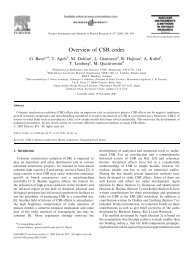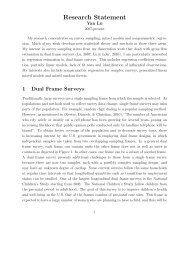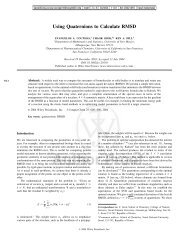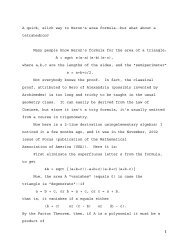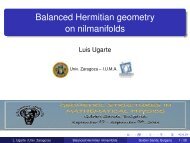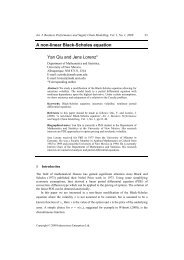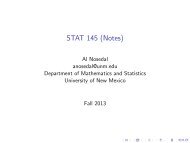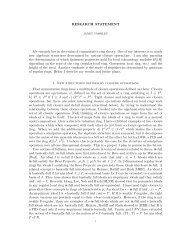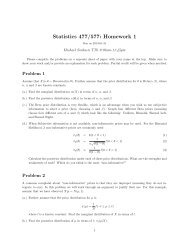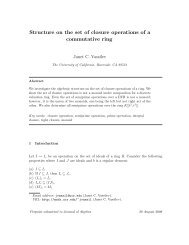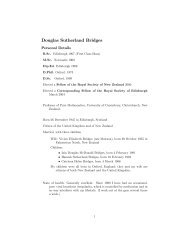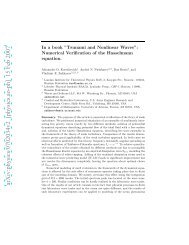Dyson's Lemma and a Theorem of Esnault and Viehweg
Dyson's Lemma and a Theorem of Esnault and Viehweg
Dyson's Lemma and a Theorem of Esnault and Viehweg
Create successful ePaper yourself
Turn your PDF publications into a flip-book with our unique Google optimized e-Paper software.
Let z j be a local parameter in O ζj ,C jso that {z 1 , . . .,z m } form a regular system <strong>of</strong> parametersfor O ζ,X . First we define an ideal I ζ,d,t ⊂ O ζ,X :⎛⎞m∏I ζ,d,t := ⎝M α = z α jjα j ≤ d j for all j <strong>and</strong> ind a (ζ, M α ) ≥ t⎠.∣j=1The definition <strong>of</strong> I ζ,d,t does not depend on the choice <strong>of</strong> local parameters {z 1 , . . .,z m }. AlthoughI ζ,d,t does depend on the choice <strong>of</strong> a used to define the index, we omit this from thenotation as a will be fixed throughout. Choose a small product affine open subsetm∏U = U j = Specj=1m⊗A jj=1with z i ∈ A i for all i so that the only zero <strong>of</strong> z i in U i is ζ i . We will continue to denote by I ζ,d,tthe ideal sheaf on U associated to I ζ,d,t . Letting f : U ֒→ X denote the natural inclusion,defineI ζ,d,t := f ∗ I ζ,d,t ∩ O X (cf. [EV1] 2.2).It is not difficult to check that the definition does not depend on the choice <strong>of</strong> U.Definition 1.2 Fix a set S ⊂ X as in <strong>Theorem</strong> 0.4 <strong>and</strong> let t i = ind a (ζ i , s). ThenM⋂I(s) := I ζi ,d,t i.i=1It is clear from the definition that s ∈ H 0 [X, L ⊗ I(s)]. In the special case where X = P<strong>and</strong> L = O P (d), the sheaf I(s) corresponds with L ′ as defined in [EV1] 2.6. Note also (cf.[EV1] 2.3) that the Riemann–Roch theorem for curves implies thatI ζ,nd,nt ⊗ F ⊗nd is generated by global sections for all n ≫ 0.There is some subtlety here because when t = m, this statement is false for an arbitrarychoice <strong>of</strong> divisors D i on C i in the definition <strong>of</strong> F d . The problem is not serious, however,because one can always add the Q–Cartier divisor ǫ ∑ mi=1 π ∗ i D i to O X (D) <strong>and</strong> F d ; one canthen verify that taking the limit as ǫ → 0 yields <strong>Theorem</strong> 0.4. We will frequently encounterthis procedure. In any case, we will always have t < m so this is not important.We will need an auxilliary sheaf M(L, S), depending on L <strong>and</strong> the finite subset S ⊂ X.This will be used to make adjustments after taking derivatives <strong>of</strong> the section s ∈ H 0 (X, L).WriteS i = π i (S) = {ζ i1 , . . ., ζ iNi }.Also if g(C i ) = 0 <strong>and</strong> N i = 1 let S i ′ = {ζ i1, ζ i2 } for a general point ζ i2 ∈ C i . Otherwise letS i ′ = S i. Finally set{maxN i ′ {Ni , 2}, if g(C=i ) = 0,N i , otherwise.7



